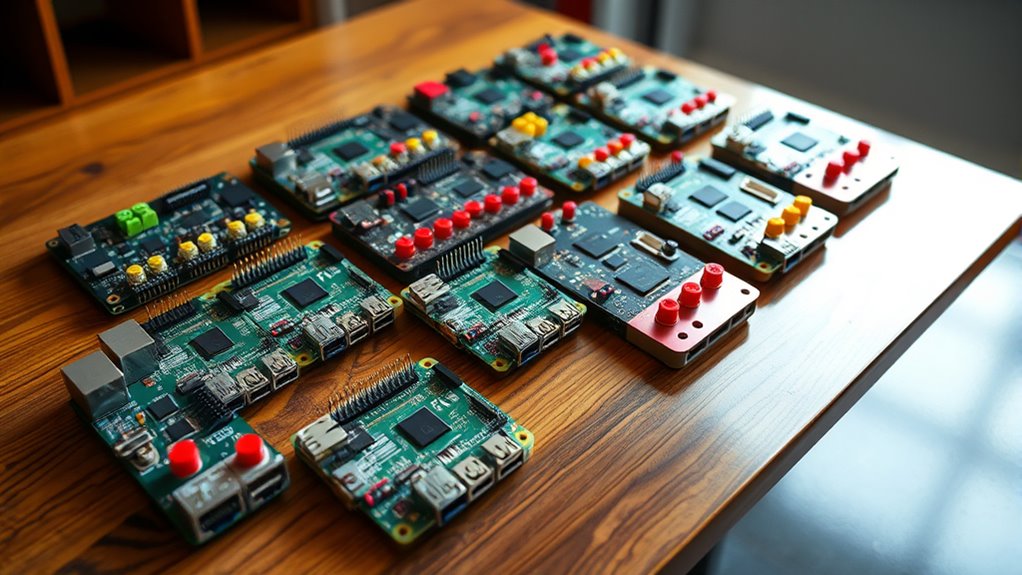If you’re into retro gaming, I’ve found the 14 best Raspberry Pi arcade hats that upgrade your setup with better audio, colorful displays, and expanded connectivity. From high-fidelity DACs and compact screens to power management and network options, these hats cater to different needs and budgets. Whether you’re building a classic gaming console or a multi-purpose media center, each offers unique features. Stay tuned to discover detailed insights that can help you choose the perfect fit for your arcade project.
Key Takeaways
- Compatibility with popular Raspberry Pi models like 4, 400, and Pi 5 for seamless retro gaming setups.
- Features like retro-themed displays, buttons, and joysticks enhance authentic arcade experiences.
- Support for preloaded emulators and game libraries simplifies setup for nostalgic gaming.
- High-quality audio HATs improve sound clarity for immersive gameplay.
- Connectivity options like GPIO, USB, and M.2 expand storage, networking, and performance for arcade projects.
InnoMaker HiFi DAC HAT for Raspberry Pi (PCM5122, RCA/3.5mm Output)

If you’re seeking top-tier audio quality for your Raspberry Pi arcade project, the InnoMaker HiFi DAC HAT stands out as an excellent choice, especially for audiophiles and serious hobbyists. It connects easily via the GPIO pins, supporting high-resolution audio with the PCM5122 DAC, up to 384kHz/32-bit. The dual outputs—RCA and 3.5mm headphone jack—deliver pristine sound with minimal jitter and crosstalk. Setup is straightforward, requiring no soldering, and it’s compatible with various streaming and music software. Many users praise its clarity, power, and ease of use, making it perfect for high-fidelity audio in your retro gaming or media center build.
Best For: audiophiles, hobbyists, and media enthusiasts seeking high-fidelity audio output from their Raspberry Pi projects, including streaming, gaming, or media centers.
Pros:
- Supports high-resolution audio up to 384kHz/32-bit with PCM5122 DAC for studio-quality sound.
- Easy plug-and-play setup via GPIO with no soldering required, compatible with multiple operating systems.
- Dual output options (RCA and 3.5mm headphone jack) with low jitter and crosstalk, ideal for high-impedance headphones and studio monitors.
Cons:
- Slightly larger size may require custom enclosures or mounting adjustments.
- Minor packaging issues reported, such as missing nuts, which do not affect functionality.
- Requires external power supply for optimal performance, adding complexity for some users.
Raspberry Pi SenseHAT
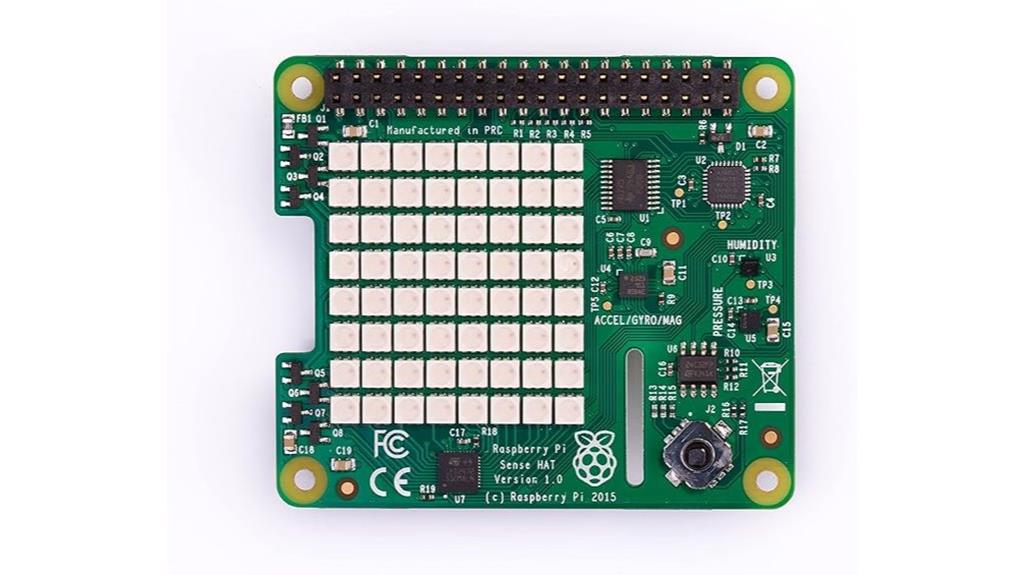
The Raspberry Pi SenseHAT stands out as an excellent choice for those interested in interactive and sensor-based projects, thanks to its array of built-in sensors and LED display. It features an 8×8 RGB LED matrix, a five-button joystick, and sensors like gyroscope, accelerometer, magnetometer, and environmental sensors for temperature, pressure, and humidity. Weighing just 1.41 ounces, it’s compact and easy to integrate with your Raspberry Pi. Originally developed for space missions, it’s now popular for education and experimentation. Its Linux compatibility, Bluetooth connectivity, and user-friendly setup make it a versatile tool for exploring sensor data and creating interactive projects.
Best For: hobbyists, educators, and students interested in sensor-based projects, interactive displays, and space-inspired experimentation using Raspberry Pi.
Pros:
- Includes a comprehensive array of sensors for diverse data collection
- Compact, lightweight, and easy to integrate with Raspberry Pi
- User-friendly setup with Linux compatibility and Bluetooth connectivity
Cons:
- Limited processing power with a single processor
- May require additional components for advanced projects
- Price may be higher compared to basic sensor modules
Generic Raspberry Pi M.2 HAT+, Green, SC1166
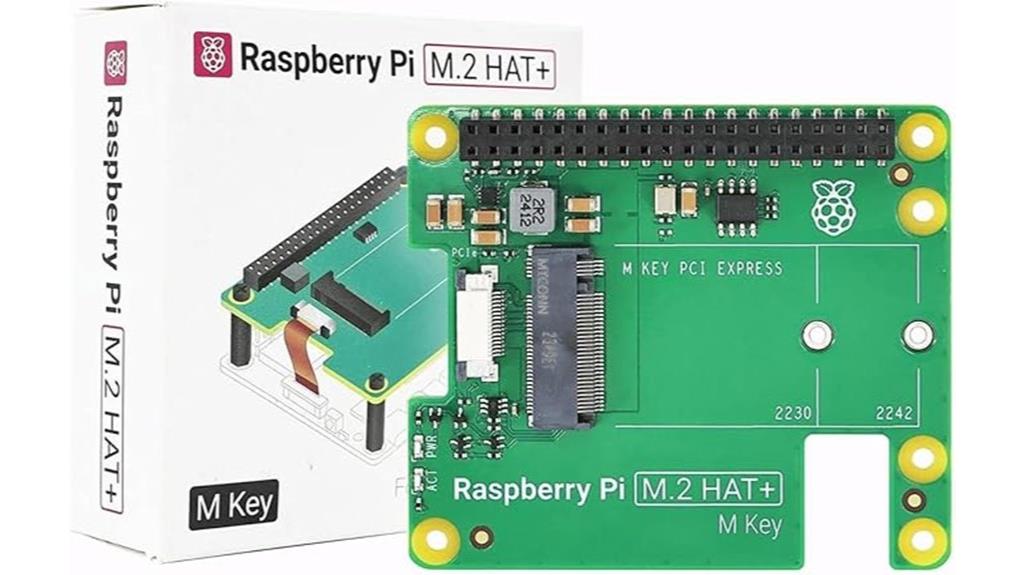
For Raspberry Pi 5 users looking to boost storage or processing power, the Generic Raspberry Pi M.2 HAT+ (Model SC1166) stands out as a versatile adapter. It’s designed specifically for Pi 5, supporting M.2 SSDs and AI modules via a PCIe 2.0 interface. The HAT+ conforms to Pi HAT+ standards, making installation straightforward with included headers and spacers, even when using the Pi Active Cooler. It provides up to 3A power—perfect for high-current devices—enhancing overall performance. Compatible with Linux, this adapter makes expanding your Raspberry Pi’s capabilities simple, whether for faster data access or added processing power.
Best For: Raspberry Pi 5 users seeking to expand storage and processing capabilities with easy installation and high power support.
Pros:
- Supports M.2 SSDs and AI modules for versatile performance enhancement
- Easy to install with included headers and spacers, compatible with Pi Active Cooler
- Supplies up to 3A power, suitable for high-current devices and demanding applications
Cons:
- Limited to PCIe 2.0 interface, which may affect maximum transfer speeds
- Compatibility restricted to Raspberry Pi 5 and specific M.2 form factors (2230, 2242)
- Requires Linux OS and may need additional configuration for optimal use
Raspberry Pi AI HAT+ 26 Tops
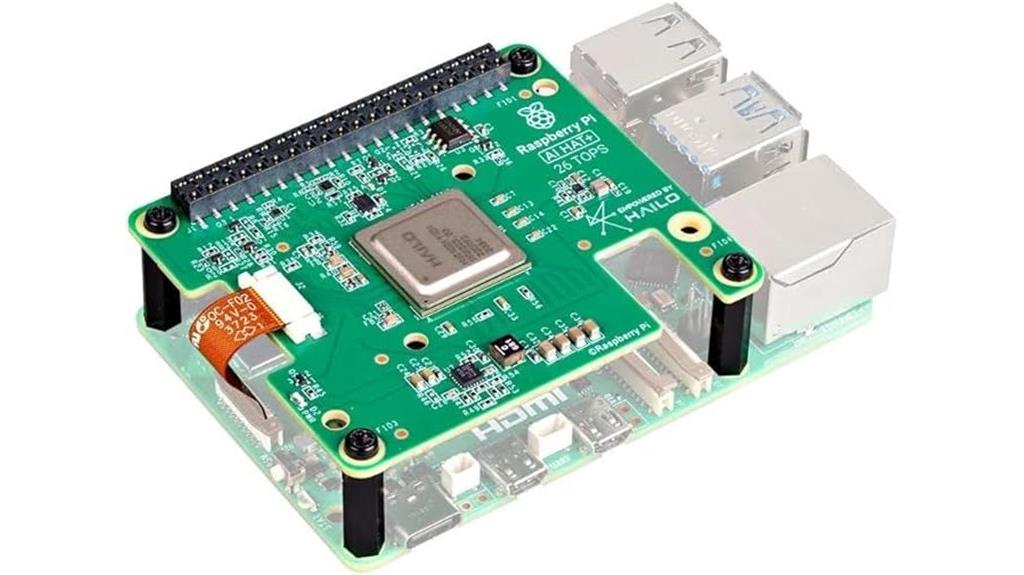
The Raspberry Pi AI HAT+ 26 Tops stands out with its powerful Hailo-8 neural network inference accelerators, making it ideal for projects that demand high-performance AI processing. It supports larger networks, runs faster, and can handle multiple networks simultaneously. Designed for the Raspberry Pi 5, it connects via PCIe Gen 3 and seamlessly integrates with Raspberry Pi OS, which detects the hardware automatically. This makes it perfect for advanced AI tasks like process control, security, or robotics. Compact, efficient, and cost-effective, the AI HAT+ 26 Tops access the hardware for AI-driven projects without breaking the bank.
Best For: AI developers and hobbyists seeking high-performance, cost-effective AI acceleration for projects like robotics, security, and automation on the Raspberry Pi 5.
Pros:
- Seamless integration with Raspberry Pi OS, requiring no complex setup
- Supports large neural networks and multiple AI models simultaneously for versatile applications
- Power-efficient design suitable for embedded and edge AI projects
Cons:
- Limited to Raspberry Pi 5 hardware, reducing adaptability with other devices
- May require some technical expertise to optimize performance and integration
- Price point might be higher compared to simpler add-ons for basic AI tasks
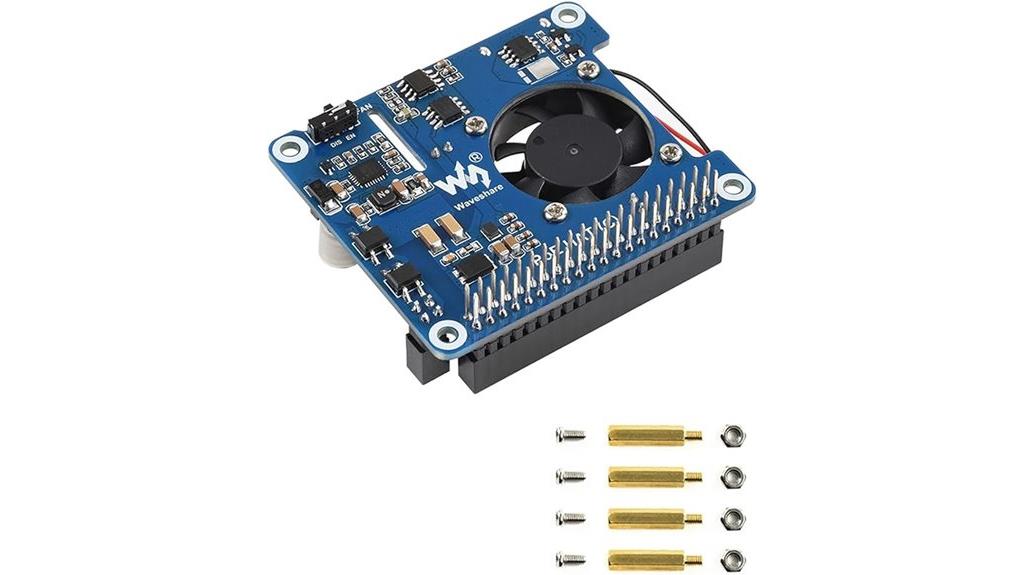
If you’re building a compact arcade setup or a networked gaming station, the Waveshare PoE HAT for Raspberry Pi 4B/3B stands out by providing power and network connectivity through a single Ethernet cable. It supports IEEE 802.3af/at PoE standards and fits seamlessly onto Raspberry Pi 3B+/4B via the 40-pin GPIO. The HAT supplies stable power with a range of 37V-57V DC and includes multiple outputs like a 5V USB-A port and 12V headers for peripherals. With an onboard active cooling fan, it helps keep your Pi cool during intensive use, though some users recommend replacing the fan for quieter operation.
Best For: DIY enthusiasts and developers building networked projects like Pi clusters, home automation, or arcade setups who need a reliable, all-in-one power and network solution for Raspberry Pi 3B+/4B.
Pros:
- Supports IEEE 802.3af/at PoE standards for simplified network and power setup
- Multiple power outputs including USB-A and 12V headers for peripherals
- Onboard active cooling fan helps maintain optimal operating temperatures
Cons:
- Fan noise and variable quality may require replacement for quieter operation
- Slight GPIO pin height considerations when stacking with cases or other HATs
- Some users report fan failure over time, impacting cooling performance
GeeekPi AI HAT+ for Raspberry Pi 5 with Hailo AI Accelerator
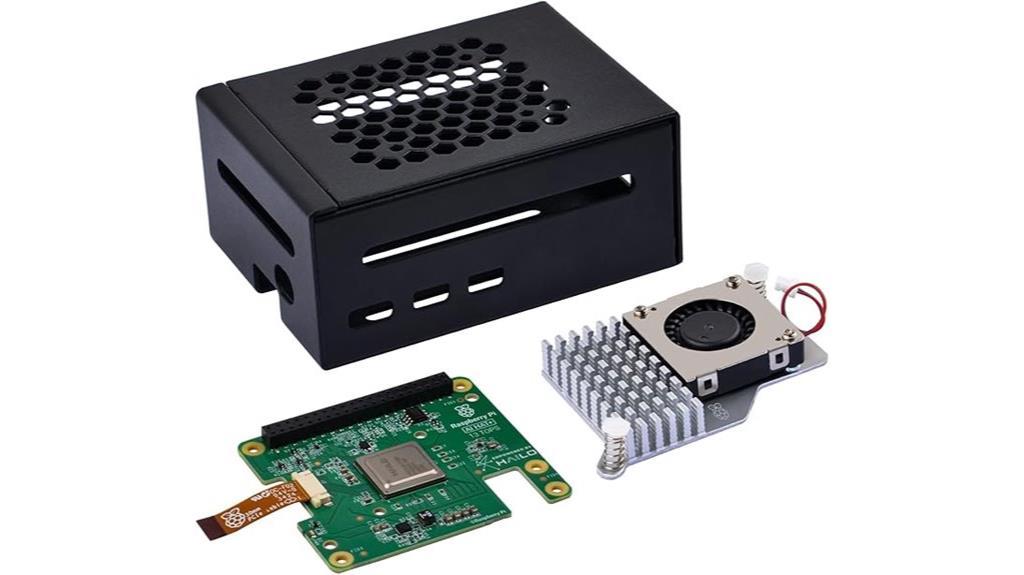
The GeeekPi AI HAT+ for Raspberry Pi 5 stands out with its powerful Hailo AI Accelerator, making it an excellent choice for those seeking to transform their Pi 5 into a high-performance AI machine. It features a built-in neural network accelerator capable of 13 TOPS, supporting advanced AI tasks like object detection and pose estimation. The HAT+ connects via the Pi 5’s PCIe Gen 3 interface and includes a metal case, active cooler, and mounting accessories, ensuring durability and supreme thermal management. Compatible with Raspberry Pi OS, it enables seamless AI processing, turning your Pi 5 into a versatile, power-efficient AI platform.
Best For: AI developers and enthusiasts looking to upgrade their Raspberry Pi 5 into a high-performance, power-efficient AI platform with advanced neural network capabilities.
Pros:
- Powerful 13 TOPS neural network performance with Hailo AI Accelerator for demanding AI tasks
- Seamless integration with Raspberry Pi 5 via PCIe Gen 3 interface and compatibility with Raspberry Pi OS
- Durable metal case with active cooling system ensures optimal thermal management and hardware protection
Cons:
- May require technical knowledge for installation and setup of the Hailo accelerator and cooling system
- Limited compatibility with non-Raspberry Pi 5 models or older Raspberry Pi OS versions
- Additional accessories like mounting hardware and cooling components may increase overall setup cost
1.44 Inch LCD Display HAT for Raspberry Pi (ST7735S)
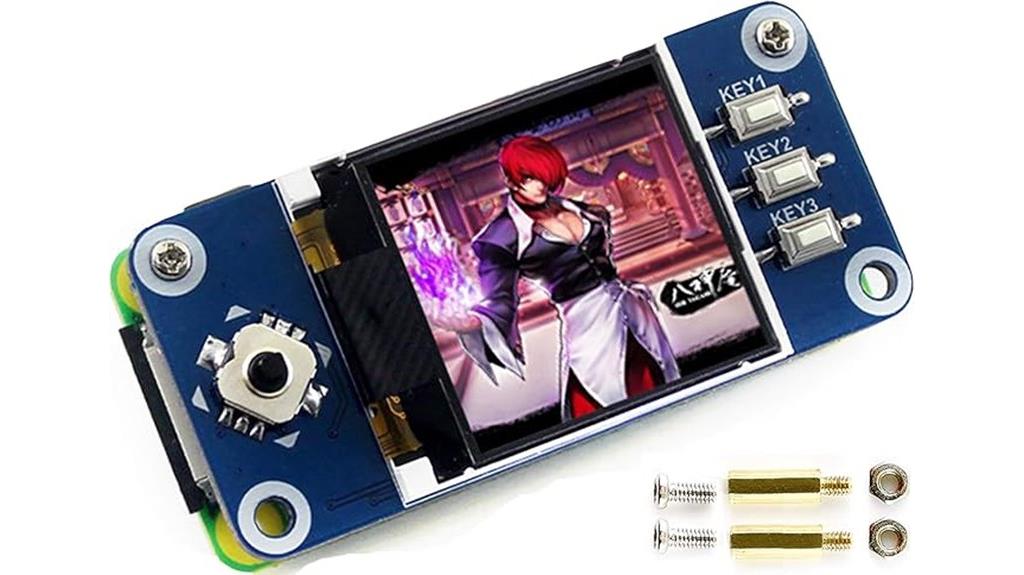
For retro gaming enthusiasts seeking a compact, colorful display, the 4 Inch LCD Display HAT with ST7735S driver is an excellent choice. This small yet vibrant 128×128 pixel display connects easily to Raspberry Pi models like the Zero and 3B+ via SPI, supporting 65K RGB colors. It features a backlit LED, a 5-position joystick, and three push buttons for user interaction. The device is straightforward to set up and compatible with multiple platforms, including Arduino and STM32. While some software support issues can arise, especially on newer OS versions, its bright colors and crisp visuals make it ideal for custom projects or status displays.
Best For: hobbyists and retro gaming enthusiasts seeking a compact, colorful display for custom Raspberry Pi projects and status indicators.
Pros:
- Bright, crisp visuals with 65K RGB color support ideal for detailed graphics and retro games.
- Easy to connect via SPI with compatibility across Raspberry Pi, Arduino, and STM32 platforms.
- Includes user interaction controls like a joystick and push buttons, enhancing project functionality.
Cons:
- Software support can be challenging on newer or 64-bit operating systems, requiring additional setup.
- Limited resolution (128×128 pixels), which may not suit high-resolution display needs.
- Potential hardware issues such as overheating or damage if not used properly or with adequate power supply.
LoveRPi Power-Over-Ethernet (PoE) HAT for Raspberry Pi 4 and 3 B
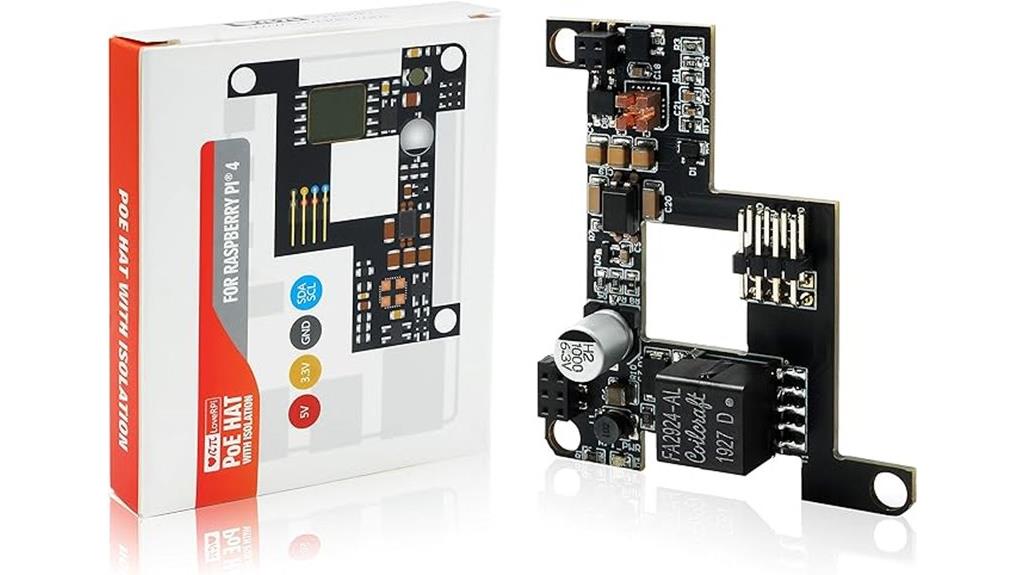
The LoveRPi Power-Over-Ethernet (PoE) HAT is an excellent choice for anyone looking to streamline power management and reduce clutter in their Raspberry Pi projects. It provides reliable 5V power via Ethernet, supporting IEEE 802.3af and 802.3at standards, with backward compatibility for Raspberry Pi 3B+ and Pi 4B. The low-profile design attaches easily to the GPIO header, making installation straightforward. With built-in protection circuitry like overvoltage and thermal shutdown, it ensures safe operation. Perfect for powering multiple Pis or creating a clean, professional setup, especially when combined with active cooling for high-performance stability.
Best For: hobbyists, professionals, and cluster builders seeking a reliable, easy-to-install PoE solution for Raspberry Pi 3B+ and 4B projects.
Pros:
- Supports IEEE 802.3af, 802.3at, and passive DC 48V networks for versatile power options.
- Provides built-in protection circuitry including overvoltage, undervoltage lockout, and thermal shutdown for safe operation.
- Compact, low-profile design that easily attaches to the GPIO header, ideal for clean and professional setups.
Cons:
- Active cooling (fan) is highly recommended, especially in enclosed cases, to prevent overheating.
- Incompatible with passive PoE unless additional isolation circuitry is used, which may complicate setup.
- External case mounting is necessary for fans to avoid short circuits and ensure proper airflow, potentially requiring extra accessories.
Sonicon Preloaded RetroPie Batocera Emulator MicroSD Card for Raspberry Pi
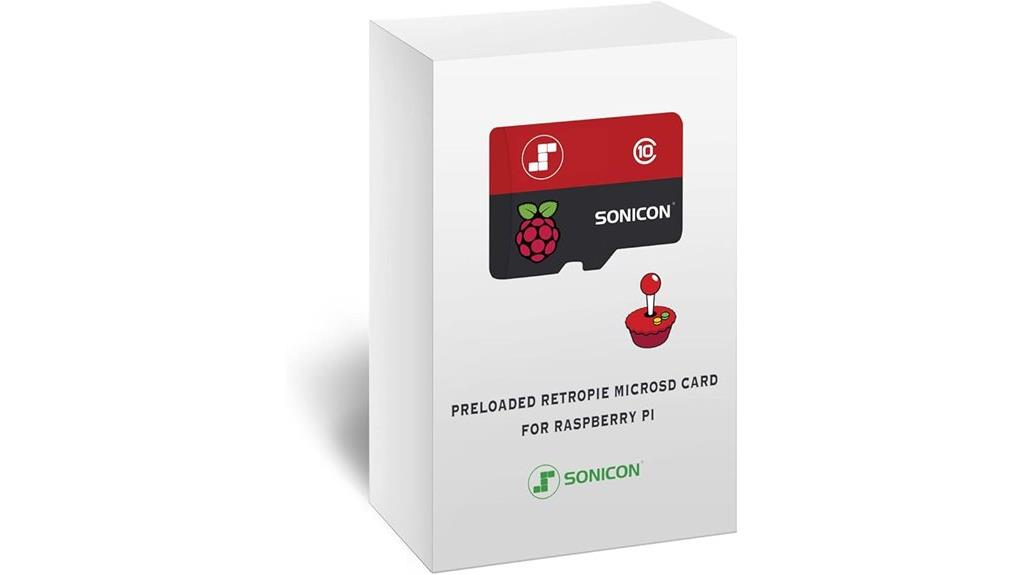
If you’re looking to transform your Raspberry Pi 5 or 4 into a ready-to-play retro gaming machine, the Sonicon Preloaded RetroPie Batocera Emulator MicroSD Card is an excellent pick. It’s designed specifically for Raspberry Pi models 4 and 5, offering a plug-and-play setup that includes a vast library of 10 tested systems like NES, Sega, PS1, and more. With 64GB capacity and fast 100 MB/s read speeds, it ensures smooth performance. The card comes preloaded with media, artwork, and emulators, plus user-friendly features like controller support and easy navigation. Backed by tech support and a 1-year warranty, it’s a convenient, high-quality solution for retro gaming enthusiasts.
Best For: retro gaming enthusiasts seeking a ready-to-use, plug-and-play Raspberry Pi solution with an extensive game library and easy setup.
Pros:
- Simple plug-and-play setup with preloaded games and emulators, saving time and effort.
- Supports multiple Raspberry Pi models (4, 4B+, 400, 5, 500) with high performance and compatibility.
- Includes media-rich features, controller support, and tech assistance, enhancing user experience.
Cons:
- Potential issues with SD card corruption, OS instability, or game loss reported by some users.
- Limited update options and possible configuration quirks, such as button mapping issues.
- The 64GB capacity may be insufficient for very extensive game collections or larger libraries.
Waveshare PoE HAT for Raspberry Pi 5

The Waveshare PoE HAT for Raspberry Pi 5 stands out as an excellent choice for those who need reliable power and efficient heat management in their retro gaming setups. It supports 802.3af/at PoE standards, providing stable power directly through Ethernet, which reduces clutter. The onboard cooling fan and large heatsink ensure effective heat dissipation during extended use, preventing overheating. Its plug-and-play design fits seamlessly with Raspberry Pi 5’s GPIO header, without blocking ports. Compatible with Linux OS and various accessories, this HAT is perfect for powering Pi clusters, home automation, or arcade projects, all while maintaining a compact and tidy setup.
Best For: DIY enthusiasts and professionals seeking a reliable, heat-managed power solution for Raspberry Pi 5 in projects like retro gaming, home automation, or server clusters.
Pros:
- Supports 802.3af/at PoE standards for stable Ethernet power delivery
- Effective heat dissipation with onboard fan and large heatsink
- Plug-and-play installation that doesn’t block GPIO pins or ports
Cons:
- Fan runs continuously at full speed without PWM control, potentially generating noise
- Some users report DOA units or fan failure after extended use
- Limited support responses for hardware issues or defects
UPS HAT for Raspberry Pi Zero Boards

For Raspberry Pi Zero users seeking uninterrupted power during their retro gaming sessions, the UPS HAT offers a reliable solution with its 5V uninterruptible power supply. It connects easily via pogo pins and features onboard spring pogo pins for simple installation. The integrated voltage boost chip ensures a stable 5V output, while the Li-po battery recharge chip manages power dynamically and safely. With I2C support, you can monitor battery voltage, current, and capacity in real time. Multi-protection circuits guard against overcharge, overdischarge, overcurrent, and short circuits, enhancing safety and reliability. This HAT keeps your Pi Zero powered smoothly, even during power outages or fluctuations.
Best For: Raspberry Pi Zero users who need a reliable, uninterruptible power supply for projects like retro gaming or remote monitoring.
Pros:
- Provides stable 5V power during outages or fluctuations.
- Easy to install with onboard spring pogo pins and pogo connector.
- Real-time monitoring of battery status via I2C support, enhancing safety and control.
Cons:
- Limited to Raspberry Pi Zero series, not compatible with larger Pi models.
- Battery life and capacity may vary depending on usage and battery condition.
- Requires careful handling of the Li-po battery for safety and longevity.
Raspberry Pi M.2 HAT

The Raspberry Pi M.2 HAT stands out as an excellent choice for enthusiasts looking to expand their Pi with high-speed storage options. It supports a single-lane PCIe 2.0 interface with a max transfer rate of 500 MB/s, making it perfect for NVMe SSDs and other peripherals. Compatible with Raspberry Pi 5 and other models, it fits M.2 M-Key drives in 2230 or 2242 sizes. Installation is straightforward, with mounting hardware included. Users report reliable performance and easy setup, though longer drives may pose compatibility issues. Overall, it’s a reliable, high-speed solution for boosting your Pi’s storage capacity.
Best For: enthusiasts and developers seeking high-speed, reliable storage expansion for their Raspberry Pi projects, particularly with NVMe SSDs and M-Key M.2 peripherals.
Pros:
- Supports high-speed PCIe 2.0 interface with up to 500 MB/s transfer rate.
- Compatible with Raspberry Pi 5 and other models, supporting 2230 and 2242 form factors.
- Easy to install with included mounting hardware, LEDs for status, and reliable connection for data transfer.
Cons:
- May have compatibility issues with longer NVMe drives.
- Mounting options can be limited when the Pi is attached to displays or other accessories.
- Not suitable for drives requiring more than 3A current or multiple lanes of PCIe.
Waveshare RS485 CAN HAT for Raspberry Pi
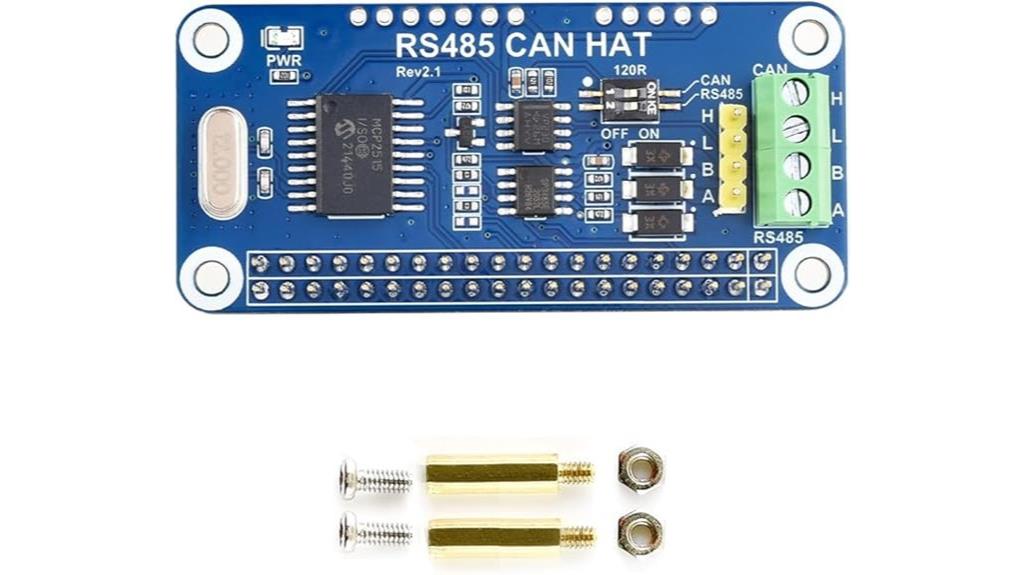
If you’re looking to connect your Raspberry Pi to industrial or vehicle networks, the Waveshare RS485 CAN HAT stands out as an excellent choice. It’s compatible with multiple Raspberry Pi models, including the Zero series and Pico variants, making it versatile for various projects. This HAT supports long-distance communication via RS485 using UART, ideal for stable data exchange over extended ranges. It also features onboard CAN controller MCP2515 and SN65HVD230 transceiver, enabling robust vehicle and industrial network connectivity. With reserved control pins, it offers flexible expansion, making it a reliable tool for integrating complex network systems with your Raspberry Pi.
Best For: embedded developers and engineers seeking reliable long-distance communication and industrial network integration with Raspberry Pi and Pico devices.
Pros:
- Supports both RS485 UART and CAN SPI protocols, offering versatile connectivity options.
- Compatible with a wide range of Raspberry Pi models and Pico variants for flexible deployment.
- Facilitates stable, long-distance data transmission suitable for industrial and vehicle networks.
Cons:
- Requires some technical knowledge for proper configuration and integration.
- May need additional accessories or shields for complete system setup.
- Operating in half-duplex mode might limit simultaneous bi-directional communication in certain applications.
Audio HAT Module for Raspberry Pi 4B/3B+/3B/2B/B+/A+/Zero/Zero W/Pi Zero WH

When adding high-quality audio to your Raspberry Pi project, the WM8960 Audio HAT Module stands out as an excellent choice, especially for those building retro gaming setups. It’s compatible with Raspberry Pi 4B, 3B+, 3B, 2B, B+, A+, Zero, Zero W, and Pi Zero WH, thanks to its standard GPIO header. The module offers stereo playback, recording, and can directly drive speakers or headphones, delivering clear Hi-Fi sound. Its compact size makes it versatile for various projects. While some driver issues may arise with newer OS versions, overall, this HAT provides excellent audio fidelity and ease of integration, making it a favorite among retro gaming enthusiasts.
Best For: DIY enthusiasts and developers seeking high-quality audio solutions for Raspberry Pi projects, especially in retro gaming, robotics, or multimedia applications.
Pros:
- High-fidelity stereo sound with excellent SNR (up to 98dB DAC quality)
- Easy integration with a standard 40-pin GPIO header across multiple Raspberry Pi models
- Supports both playback and recording with included microphones and speaker options
Cons:
- Potential driver compatibility issues with newer Raspberry Pi OS versions
- Size constraints of connected speakers may limit certain applications
- Some users experience difficulties with USB audio adapters or microphone functionality depending on setup
Factors to Consider When Choosing a Raspberry Pi Arcade Hat
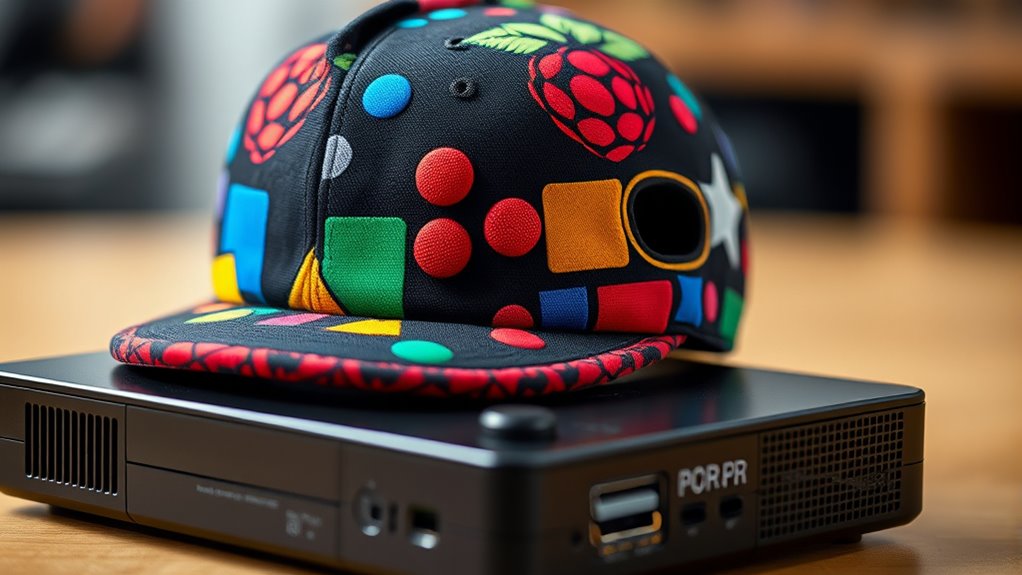
When selecting a Raspberry Pi arcade hat, I consider factors like compatibility with my Pi model and the quality of the display, since these affect gameplay. I also look at audio options, power stability, and how easy it is to install, so my setup is smooth and reliable. Understanding these points helps me choose an arcade hat that fits my needs perfectly.
Compatibility With Raspberry Pi
Choosing a Raspberry Pi arcade hat requires guaranteeing it’s compatible with your specific model, such as the Pi 4, Pi 3B+, or Zero W, to make sure it fits properly and functions correctly. Check the required GPIO pin connections and physical dimensions to confirm it fits your case and layout. It’s also essential to verify that the hat supports your intended operating system, like Raspberry Pi OS or other Linux distributions. Additionally, review the power requirements to verify your power supply can handle the hat without under-voltage issues. Don’t forget to take into account compatibility with any peripherals or accessories you plan to use alongside the arcade hat. Being thorough here prevents compatibility issues later, allowing for a smooth setup and optimal gaming experience.
Display Quality and Size
The display size on a Raspberry Pi arcade hat considerably influences how you’ll experience retro games, with options ranging from compact 1.44-inch screens to larger 3.5-inch displays. Smaller screens are portable and conserve power but may restrict visibility and detail. Larger displays offer better visibility and more immersive visuals, making gameplay more enjoyable. Higher resolution screens, like 128×128 pixels, deliver clearer graphics and sharper visuals, enhancing the retro experience. The choice of technology—LCD or OLED—also matters, as OLED screens provide better brightness, contrast, and vibrant colors, though they may consume more power. Brightness and color support, such as 65K RGB colors, affect visual vibrancy. Compatibility with the Raspberry Pi’s GPIO and software ensures smooth integration, maximizing the display’s capabilities.
Audio Output Options
Audio output options profoundly impact your gaming experience, especially if you want immersive sound effects or clear music during arcade sessions. When choosing a Raspberry Pi arcade hat, look for those that offer analog audio outputs via RCA or 3.5mm jacks, making it easy to connect speakers or headphones directly. Some HATs feature high-fidelity DAC chips with excellent signal-to-noise ratios, ensuring crisp, high-quality audio playback for arcade emulators. The presence of dedicated headphone amplifiers can boost volume and clarity for personal listening, enhancing immersion. Compatibility with existing audio peripherals and support for both line-out and microphone input add versatility. In conclusion, proper grounding and shielding on the HAT minimize electrical noise, preserving audio fidelity and providing a cleaner, more enjoyable gaming experience.
Power Requirements and Stability
Ensuring your Raspberry Pi arcade hat has reliable power requirements is essential for a smooth gaming experience. Make sure the HAT has a stable power input compatible with your Pi model, whether through GPIO pins or dedicated ports. It’s vital that your power supply can deliver at least 2A to support the Pi and peripherals like buttons and displays. Check if the HAT includes integrated power regulation and filtering to prevent voltage fluctuations that could cause crashes or instability. Some HATs support power management features like safe shutdown and power monitoring, adding an extra layer of protection. Always use a high-quality, noise-free power source, such as a regulated USB adapter or linear power supply, to maintain consistent voltage and minimize electrical noise that could affect gameplay.
Ease of Installation
Choosing a Raspberry Pi arcade HAT that’s easy to install can save you a lot of time and frustration. Look for a HAT with clear, step-by-step instructions to make setup straightforward. Opt for models with minimal hardware requirements, like no soldering or external wiring, so you can avoid complicated assembly. Compatibility with your specific Raspberry Pi model is essential to prevent installation issues. Additionally, consider HATs that come with mounting hardware, such as screws or standoffs, which simplify the process of attaching everything securely. Finally, choose a product backed by extensive documentation and active community support. These resources can be invaluable if you encounter any troubles during installation, ensuring a smooth and hassle-free setup experience.
Additional Features and Expandability
When selecting a Raspberry Pi arcade HAT, it’s important to contemplate how well it can grow with your gaming setup. Look for HATs that offer multiple GPIO pin access or stacking capabilities, so you can add peripherals like extra buttons or sensors later. Consider whether it supports expanding storage options, such as M.2 or additional SD card slots, to accommodate larger game libraries. Built-in controls like buttons and joysticks can enhance gameplay immediately, but check if the HAT supports firmware or software updates—this guarantees you can add new features or improve compatibility down the line. Also, assess audio options like speakers or headphone jacks for immersive sound. These features ensure your arcade setup remains versatile, adaptable, and ready for future upgrades.
Frequently Asked Questions
Can These Arcade HATS Support Multiplayer Gaming Setups?
Yes, most Raspberry Pi arcade hats support multiplayer gaming setups. I’ve found that many models include multiple controller ports or can easily connect additional controllers via USB or GPIO pins. This allows me to set up local multiplayer games effortlessly. Just confirm the hat you choose mentions support for multiple controllers or has enough GPIO pins for your needs, and you’ll be able to enjoy multiplayer retro gaming without any issues.
Are There Specific Power Requirements for Different Arcade HATS?
Think of each arcade hat as a different vehicle needing its own fuel. Some require a standard power supply, while others might need a bit more juice—like a high-performance sports car. Most Raspberry Pi arcade hats work with the Pi’s usual power input, but always check the manufacturer’s specs. Using the right power guarantees your gaming ride runs smoothly without hiccups or crashes, keeping your retro adventures on track.
Do They Include Built-In Controls or Buttons for Gameplay?
Most arcade hats I’ve used do include built-in controls and buttons, making gameplay straightforward without extra peripherals. They usually feature directional pads, action buttons, and sometimes shoulder buttons for a more authentic experience. I find this setup ideal because it simplifies assembly and saves space. However, some hats let you customize controls or add external buttons if you want a more tailored gaming setup.
Can These HATS Be Used With Raspberry Pi Zero Models?
Yes, many Raspberry Pi arcade hats are compatible with the Pi Zero models, but you need to double-check each hat’s specifications. Some are designed specifically for the smaller form factor, while others may require additional adapters or modifications. I recommend reviewing the product details carefully to verify compatibility. If you’re comfortable with DIY projects, most hats can be adapted for Pi Zero with a bit of effort.
Are Software Compatibility Issues Common With Certain Arcade HATS?
Yes, software compatibility issues can be common with certain arcade hats. I’ve experienced this myself, especially with older or less popular models that may not have updated drivers or community support. It’s always a good idea to check the hat’s compatibility list and user reviews before buying. Sometimes, a simple software tweak or firmware update can fix these issues, but other times, compatibility problems can be a real headache.
Conclusion
Choosing the right Raspberry Pi arcade hat is like selecting the perfect game controller—each one offers unique features that can make or break your retro gaming experience. I once struggled with a noisy setup until I found the right DAC HAT; suddenly, my games sounded clear as day. Remember, the right accessory transforms your project from good to great, just like the perfect game controller turns a rough level into a memorable adventure.
